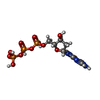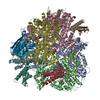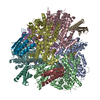+Search query
-Structure paper
| Title | Mechanism by which T7 bacteriophage protein Gp1.2 inhibits dGTPase. |
|---|---|
| Journal, issue, pages | Proc Natl Acad Sci U S A, Vol. 119, Issue 37, Page e2123092119, Year 2022 |
| Publish date | Sep 13, 2022 |
 Authors Authors | Bradley P Klemm / Deepa Singh / Cassandra E Smith / Allen L Hsu / Lucas B Dillard / Juno M Krahn / Robert E London / Geoffrey A Mueller / Mario J Borgnia / Roel M Schaaper /  |
| PubMed Abstract | Levels of the cellular dNTPs, the direct precursors for DNA synthesis, are important for DNA replication fidelity, cell cycle control, and resistance against viruses. encodes a dGTPase (2'- ...Levels of the cellular dNTPs, the direct precursors for DNA synthesis, are important for DNA replication fidelity, cell cycle control, and resistance against viruses. encodes a dGTPase (2'-deoxyguanosine-5'-triphosphate [dGTP] triphosphohydrolase [dGTPase]; gene, Dgt) that establishes the normal dGTP level required for accurate DNA replication but also plays a role in protecting against bacteriophage T7 infection by limiting the dGTP required for viral DNA replication. T7 counteracts Dgt using an inhibitor, the gene product (Gp1.2). This interaction is a useful model system for studying the ongoing evolutionary virus/host "arms race." We determined the structure of Gp1.2 by NMR spectroscopy and solved high-resolution cryo-electron microscopy structures of the Dgt-Gp1.2 complex also including either dGTP substrate or GTP coinhibitor bound in the active site. These structures reveal the mechanism by which Gp1.2 inhibits Dgt and indicate that Gp1.2 preferentially binds the GTP-bound form of Dgt. Biochemical assays reveal that the two inhibitors use different modes of inhibition and bind to Dgt in combination to yield enhanced inhibition. We thus propose an in vivo inhibition model wherein the Dgt-Gp1.2 complex equilibrates with GTP to fully inactivate Dgt, limiting dGTP hydrolysis and preserving the dGTP pool for viral DNA replication. |
 External links External links |  Proc Natl Acad Sci U S A / Proc Natl Acad Sci U S A /  PubMed:36067314 / PubMed:36067314 /  PubMed Central PubMed Central |
| Methods | EM (single particle) |
| Resolution | 2.5 - 3.1 Å |
| Structure data | EMDB-26360, PDB-7u65: EMDB-26361, PDB-7u66: EMDB-26362, PDB-7u67: |
| Chemicals |  ChemComp-MG:  ChemComp-DGT:  ChemComp-GTP: |
| Source |
|
 Keywords Keywords |  HYDROLASE / HYDROLASE /  dGTPase / dGTPase /  inhibitor / inhibitor /  complex / substrate complex / substrate |
 Movie
Movie Controller
Controller Structure viewers
Structure viewers About Yorodumi Papers
About Yorodumi Papers












